Experimental Study on the Electrical Resistivity Characteristics of Uniformly Graded Calcareous Sand
Abstract
:1. Introduction
2. Materials and Methods
2.1. Test Devices
2.2. Test Material
2.3. Test Setup
- (1)
- The surface of the dried calcareous sand particles may have contained salt and dust. Pure water was used to repeatedly clean the dried calcareous sand.
- (2)
- The cleaned calcareous sand was placed in an oven and dried at 105~110 °C for at least 8 h. The sand was taken out of the oven and placed in a bag for later use.
- (3)
- After drying, a soil sieve was used to shake and sieve the calcium sand for 10 min to obtain three types of calcium sand with size fractions of 1–1.5 mm, 1.5–2 mm, and 2–2.5 mm. They were placed in separate bags for future use.
- (4)
- According to the experimental plan, certain amounts of calcareous sand and water were weighed, mixed evenly, put into a bag, sealed, and allowed to stand for 24 h.
- (5)
- A sample was inserted into the sample box, the electrodes were connected at both ends of the sample to the digital bridge measurement port, and the resistance value was read. The data reading was completed within seconds, ignoring the impact of the sample’s previous electrification on the test results [16]. Simultaneously, the indoor temperature was controlled within the range of 20 ± 2 °C to reduce the impact of the test temperature on the results [17,18].
2.4. Test Plans
3. Correction of the Electrical Resistivity of Calcareous Sand
4. Results and Discussion
4.1. Effect of Temperature on the Electrical Resistivity of Single Size Fraction of Saturated Calcareous Sand
4.2. Effect of Pore Water Resistivity on the Electrical Resistivity of Single Size Fraction of Calcareous Sand
4.3. Effect of Saturation on the Electrical Resistivity of Single Size Fraction of Calcareous Sand
4.4. Effect of Relative Density on the Electrical Resistivity of Single Size Fraction of Calcareous Sand
5. Conclusions
- (1)
- As the temperature increased, the resistance of the calcareous sand sample gradually decreased, and the relationship between temperature and resistance was approximately linear. For calcareous sand with size fractions of 1–1.5 mm, 1.5–2 mm, and 2–2.5 mm, the resistivity decreased by 0.48 Ω·m, 0.94 Ω·m, and 1.15 Ω·m for each 1 °C increase. The research results can provide support for temperature correction of calcareous sand resistivity.
- (2)
- When the pore solutions were pure water, tap water, 1% NaCl salt solution, 2% NaCl salt solution, 4% NaCl salt solution, and 6% NaCl salt solution, the resistivity of calcareous sand showed a significant downwards trend, and the differences in resistivity values were significant. When the concentration of NaCl was high, the influence of particle size on the resistivity of saturated calcareous sand could be ignored.
- (3)
- The resistivities of three size fractions of calcareous sands decreased with increasing saturation, and the relationship between them was a power function. When they were close to full saturation, the rate of resistivity decline gradually decreased. When the calcareous sands were fully saturated, their resistivity reached the minimum.
- (4)
- The larger the porosity of calcareous sands was, the lower the resistivity was. The relationship between the resistivity and relative density of calcareous sand was established using a linear function. The research results can provide support for the establishment of the relationship between particle breakage and electrical resistivity of calcareous sand in the future.
Author Contributions
Funding
Institutional Review Board Statement
Informed Consent Statement
Data Availability Statement
Acknowledgments
Conflicts of Interest
References
- Fukue, M.; Minato, T.; Horibe, H.; Taya, N. The micro-structures of clay given by resistivity measurements. Eng. Geol. 1999, 54, 43–53. [Google Scholar] [CrossRef]
- Yu, X.J.; Liu, S.Y. Researches on application of electrical resistivity indices to the microstructure of expansive soils. Chin. J. Geo. Eng. 2004, 26, 393–396. [Google Scholar] [CrossRef]
- Zha, F.S.; Liu, S.Y.; Du, Y.J.; Cui, K.R.; Xu, L. Quantitative assessment on change in microstructure of loess during collapsing using electrical resistivity measurement. Rock Soil Mech. 2010, 31, 1692–1698. [Google Scholar] [CrossRef]
- Lévesque, Y.; Walter, J.; Chesnaux, R.; Dugas, S.; Noel, D. Electrical resistivity of saturated and unsaturated sediments in northeastern Canada. Environ. Earth Sci. 2023, 82, 303. [Google Scholar] [CrossRef]
- Cao, Z.G.; Xiang, L.; Peng, E.X.; Li, K. Experimental Study on Electrical Resistivity of Cement-Stabilized Lead-Contaminated Soils. Adv. Civ. Eng. 2018, 2018, 4628784. [Google Scholar] [CrossRef]
- Shen, J.; Mao, H.; Wang, Z.; Yan, L.; Tang, X. Influence of Electrode Contact and Distance on Soil Resistivity Measuremen. Acta Pedol. Sin. 2019, 56, 1247–1258. [Google Scholar] [CrossRef]
- Rinaldi, V.A.; Cuestas, G.A. Ohmic Conductivity of a Compacted Silty Clay. J. Geo. Geoenviron. Eng. 2002, 128, 824–835. [Google Scholar] [CrossRef]
- Archie, G.E. The Electrical Resistivity Log as an Aid in Determining Some Reservoir Characteristics. Soc. Pet. Eng. 1942, 146, 54–62. [Google Scholar] [CrossRef]
- Qi, Y.; Wang, M.; Zhang, D.; Lin, W. Correction method of Archie resistivity model for methyl tert-butyl ether contaminated clay. Rock Soil Mech. 2023, 44, 1719–1728. [Google Scholar] [CrossRef]
- Chu, Y.; Liu, S.Y.; Cai, G.J.; Bian, H.L. Research Progress of Resistivity Models for Geotechnical Engineering. J. Nanjing Inst. Technol. (Nat. Sci. Ed.) 2017, 15, 1–9. [Google Scholar]
- Chen, R.P.; Chen, W.; Wang, J.X.; Chen, Y.M. Electrical conductivity of pore water in saturated sand and its measurement technology. Chin. J. Geo. Eng. 2010, 32, 780–783. [Google Scholar]
- Keller, G.V.; Frischknecht, F.C. Electrical Methods in Geophysical Prospecting; Pergamom Press: New York, NY, USA, 1966. [Google Scholar]
- Hu, M.J.; Jiang, H.H.; Cui, X.; Ruan, Y.; Liu, H.F.; Zhang, C.Y. Preliminary study of conductivity and correlation problems of calcareous sand. Rock Soil Mech. 2017, 38, 158–162. [Google Scholar] [CrossRef]
- Zhu, C.Q.; Cui, X.; Hu, M.J.; Wang, X.Z.; Tang, J.J. Study of electric conductivity and permeability of calcareous soil. Rock Soil Mech. 2018, 39, 142–148. [Google Scholar] [CrossRef]
- Dias, C.A. Analytical model for a polarizable medium at radio and lower frequencies. J. Geophys. Res. 1972, 77, 4945–4956. [Google Scholar] [CrossRef]
- Wang, B.H.; Wang, Z.H.; Jiang, P.M.; Zhou, A.Z. Electrical resistivity characteristics of saturated sand with varied porosities. Chin. J. Geo. Eng. 2017, 39, 1739–1745. [Google Scholar] [CrossRef]
- Bai, W.; Kong, L.W.; Guo, A.G. Effects of physical properties on electrical conductivity of compacted lateritic soil. J. Rock Mech. Geo. Eng. 2013, 5, 406–411. [Google Scholar] [CrossRef]
- Campbell, R.B.; Bower, C.A.; Richards, L.A. Change of Electrical Conductivity with Temperature and the Relation of Osmotic Pressure to Electrical Conductivity and Ion Concentration for Soil Extracts. Soil Sci. Soc. Am. J. 1949, 13, 66–69. [Google Scholar] [CrossRef]
- Zhuang, Y.F.; Wang, Z. Interface Electric Resistance of Electroosmotic Consolidation. J. Geo. Geoenviron. Eng. 2007, 133, 1617–1621. [Google Scholar] [CrossRef]
- López-Sánchez, M.; Mansilla-Plaza, L.; Sánchez-de-Laorden, M. Geometric factor and influence of sensors in the establishment of a resistivity-moisture relation in soil samples. J. Appl. Geophys. 2017, 145, 1–11. [Google Scholar] [CrossRef]
- Abu-Hassanein, Z.S.; Benson, C.H.; Blotz, L.R. Electrical Resistivity of Compacted Clays. J. Geo. Eng. 1996, 122, 397–406. [Google Scholar] [CrossRef]
- Xie, R.Z.; Chen, Z.G.; Feng, C.; He, B.; Ma, F.L.; Han, P.J. Electrochemical impedance spectroscopy of sand of varied particle size and water content using the three-electrode system. Mater. Test. 2018, 60, 841–847. [Google Scholar] [CrossRef]
- Liu, G.H.; Wang, Z.Y.; Huang, J.P. Research on electrical resistivity feature of soil and its application. Chin. J. Geo. Eng. 2004, 26, 83–87. [Google Scholar] [CrossRef]
- Song, Z.W.; Dong, X.Q.; Gao, Y.T.; Shen, J.W.; Liu, X.F. Experimental analysis of AC resistivity properties of zinc contaminated sand. J. Civ. Archit. Environ. Eng. 2015, 37, 60–65. [Google Scholar]
- Zhou, M.; Wang, J.G.; Huang, S.B.; Dou, P.; Zhang, L.Q.; Yao, W. Experimental investigation on influencing factors in soil resistivity measurement. Rock Soil Mech. 2011, 32, 3269–3275. [Google Scholar] [CrossRef]
- Friedman, S.P.; Robinson, D.A. Particle shape characterization using angle of repose measurements for predicting the effective permittivity and electrical conductivity of saturated granular media. Water Resour. Res. 2002, 38, 1–11. [Google Scholar] [CrossRef]
- Jackson, P.D.; Smith, D.T.; Stanford, P.N. Resistivity-Porosity-Particle Shape Relationships for Marine Sands. Geophysics 1978, 43, 1250–1268. [Google Scholar] [CrossRef]
- Gao, Y.C.; Zhang, C.X.; Wang, B.H. Effect of particle size on resistivity of saturated sand. J. Yangzhou Univ. (Nat. Sci. Ed.) 2017, 20, 66–69. [Google Scholar] [CrossRef]
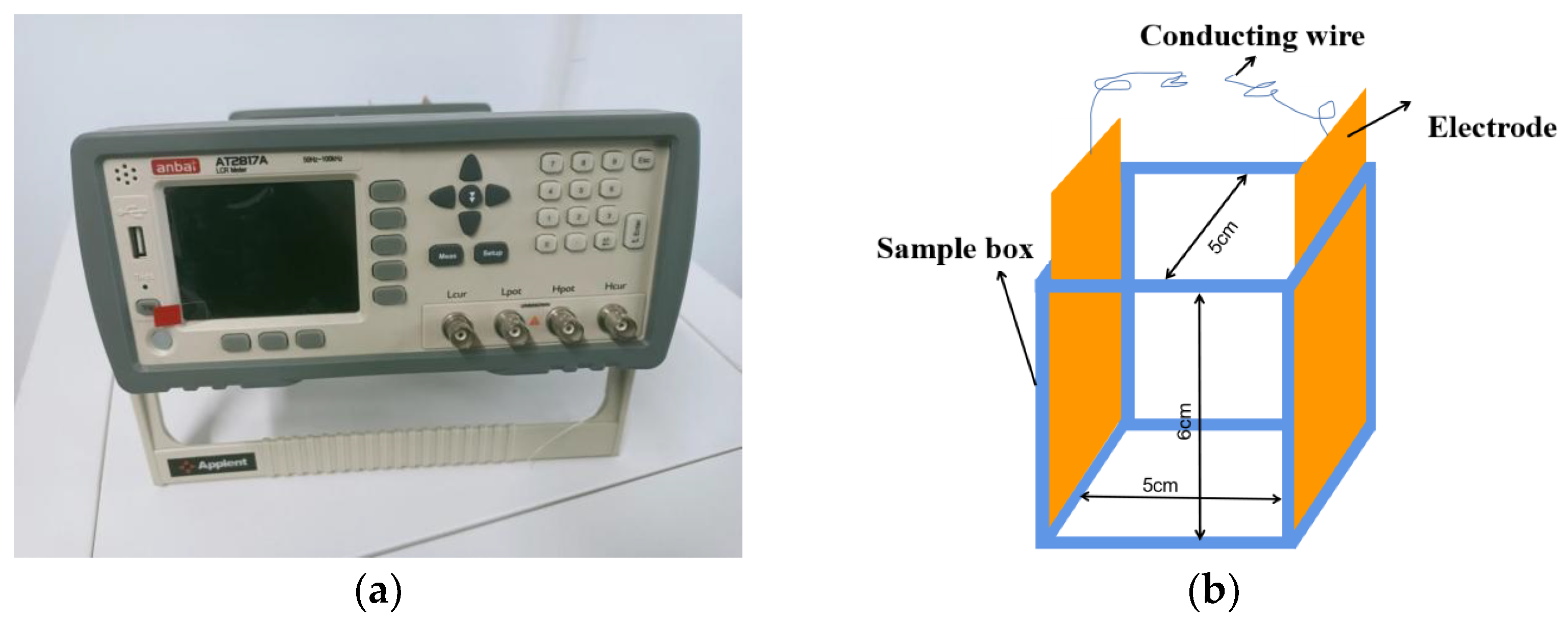

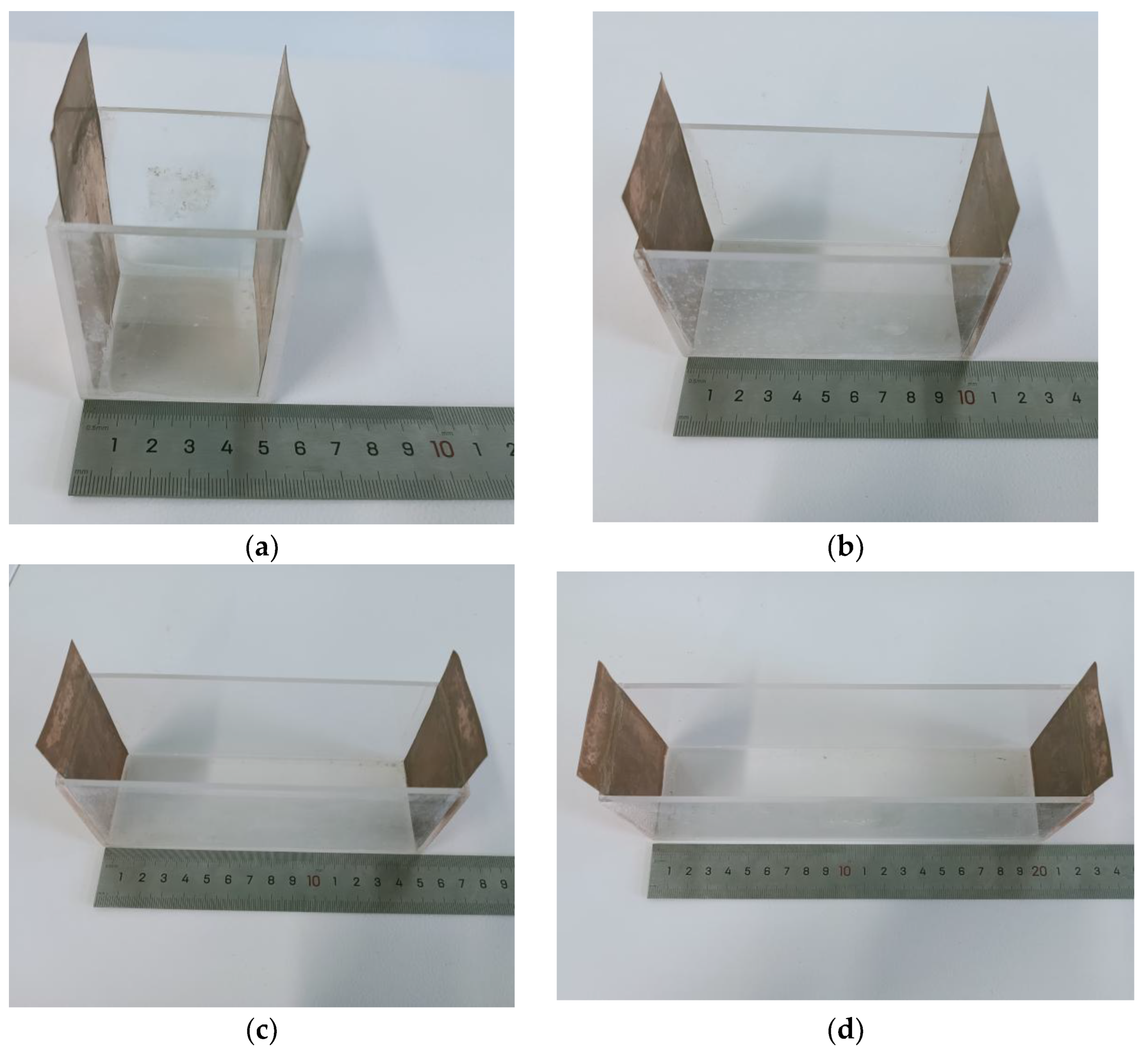
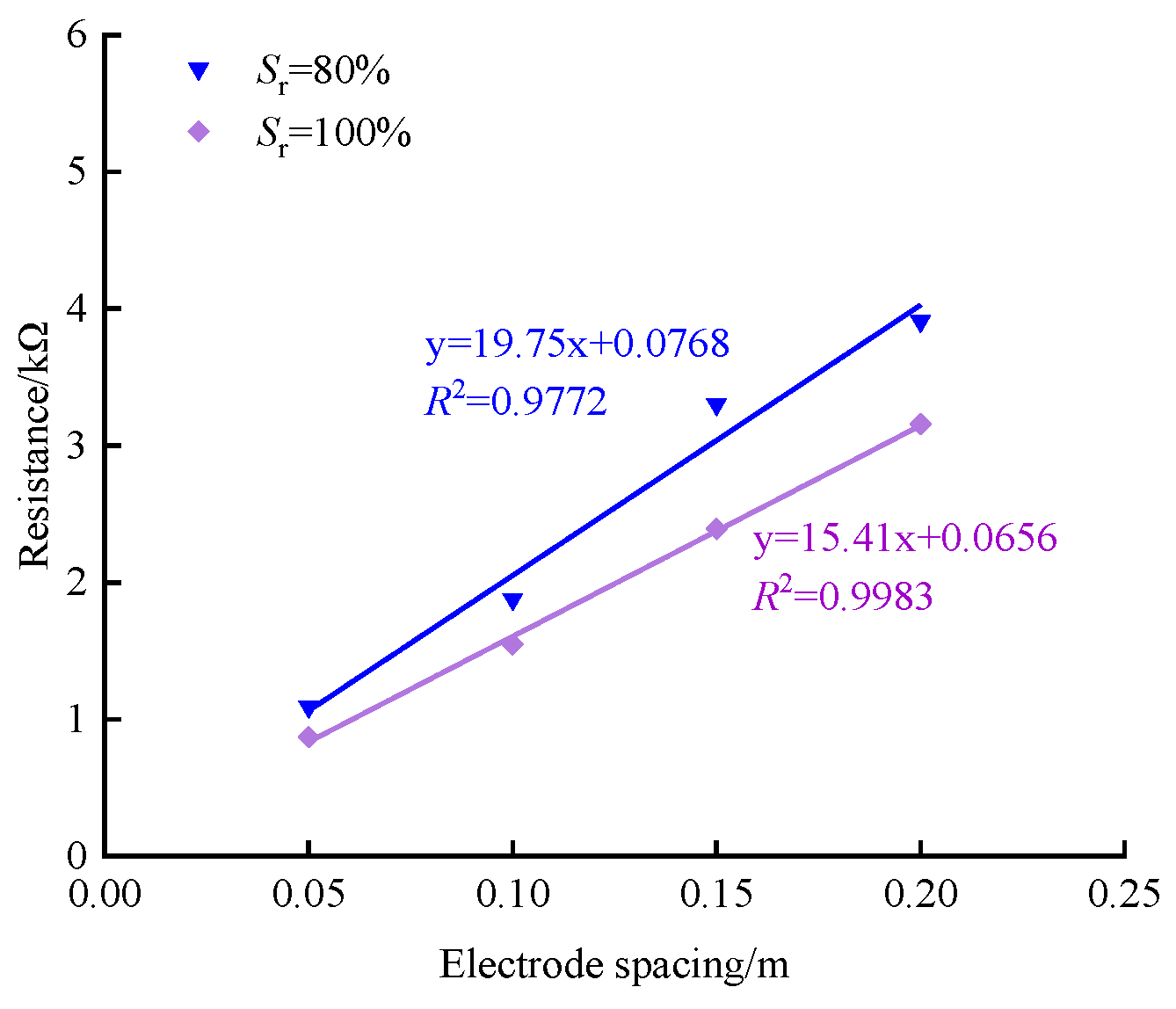
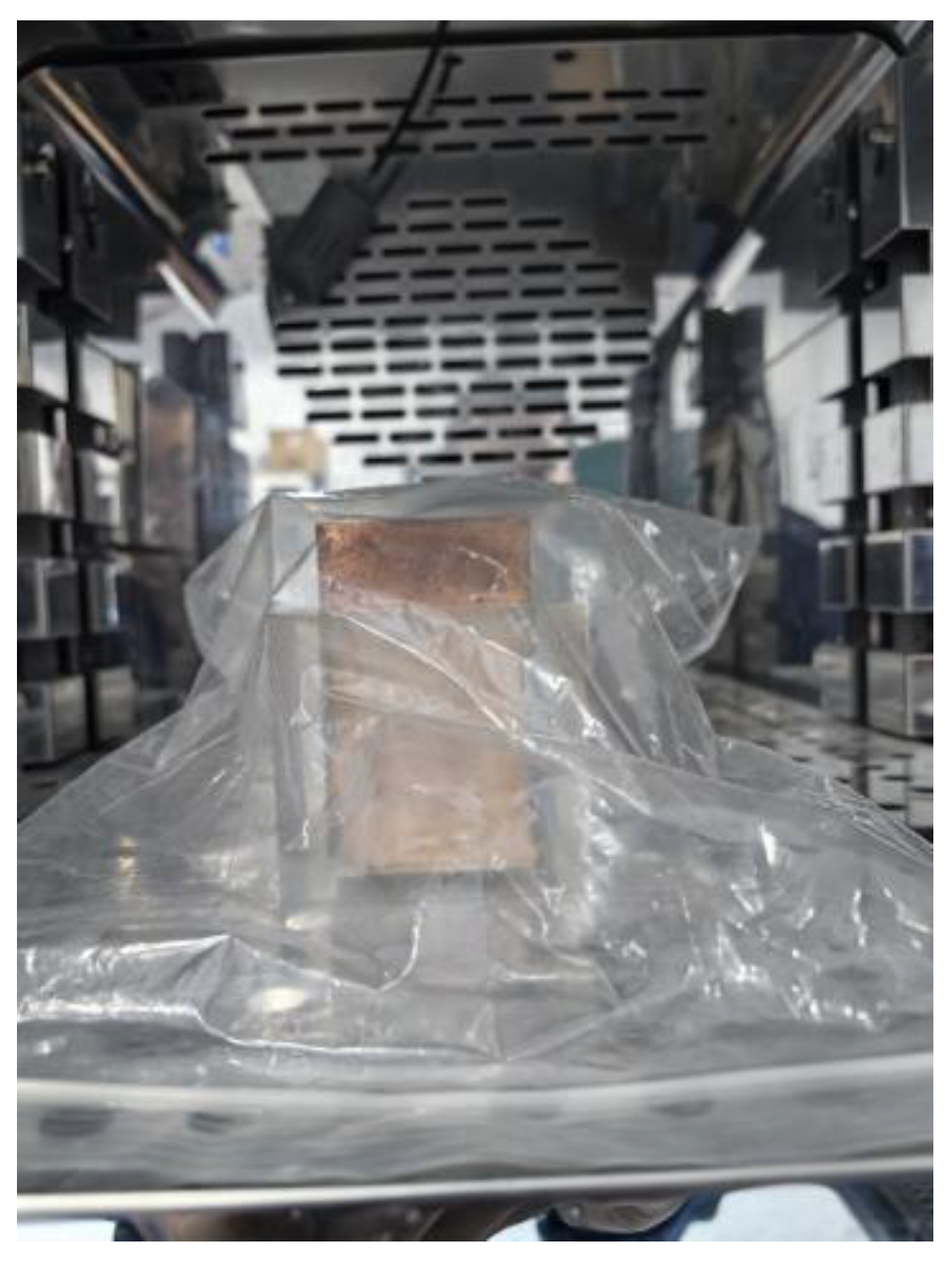



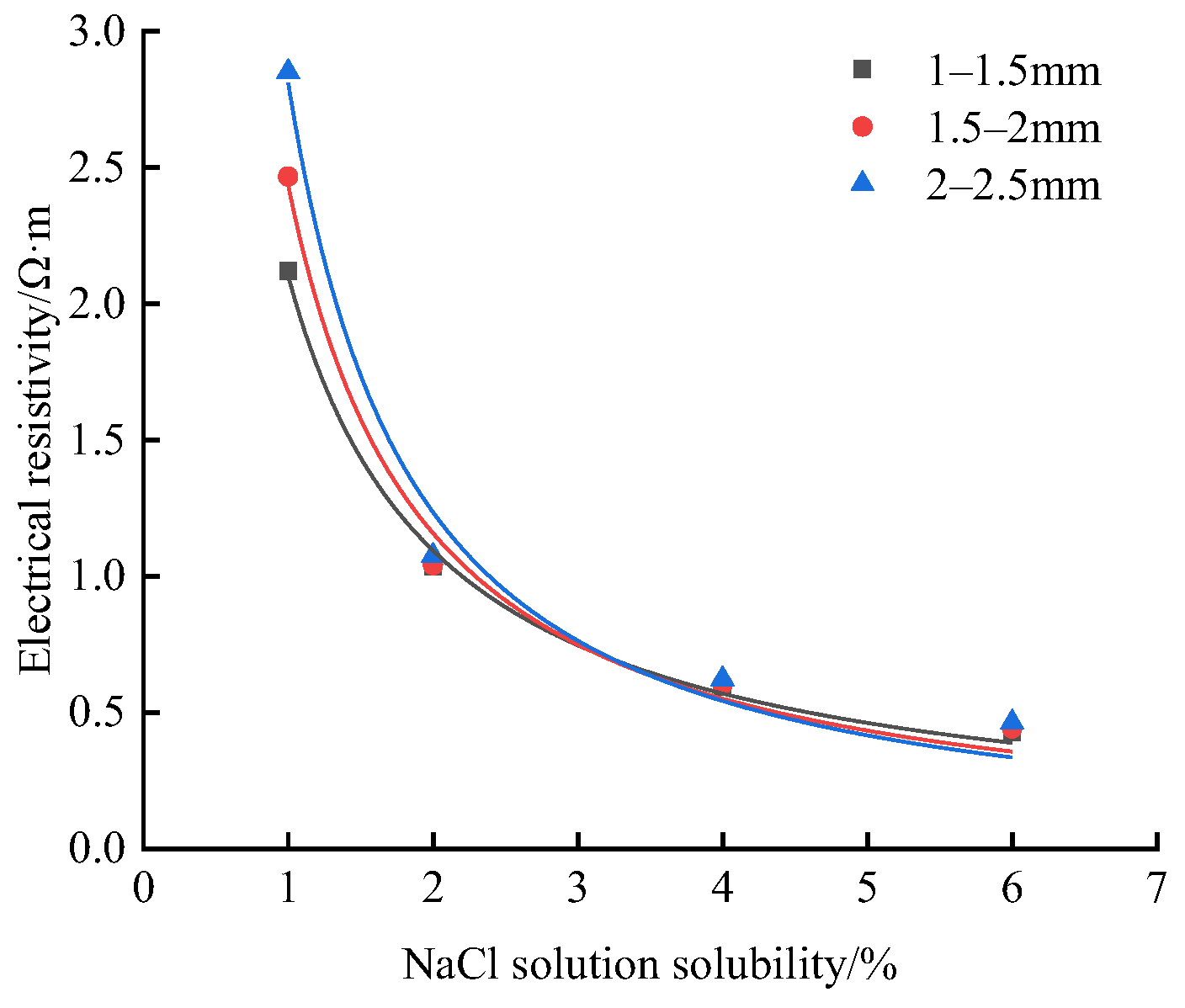


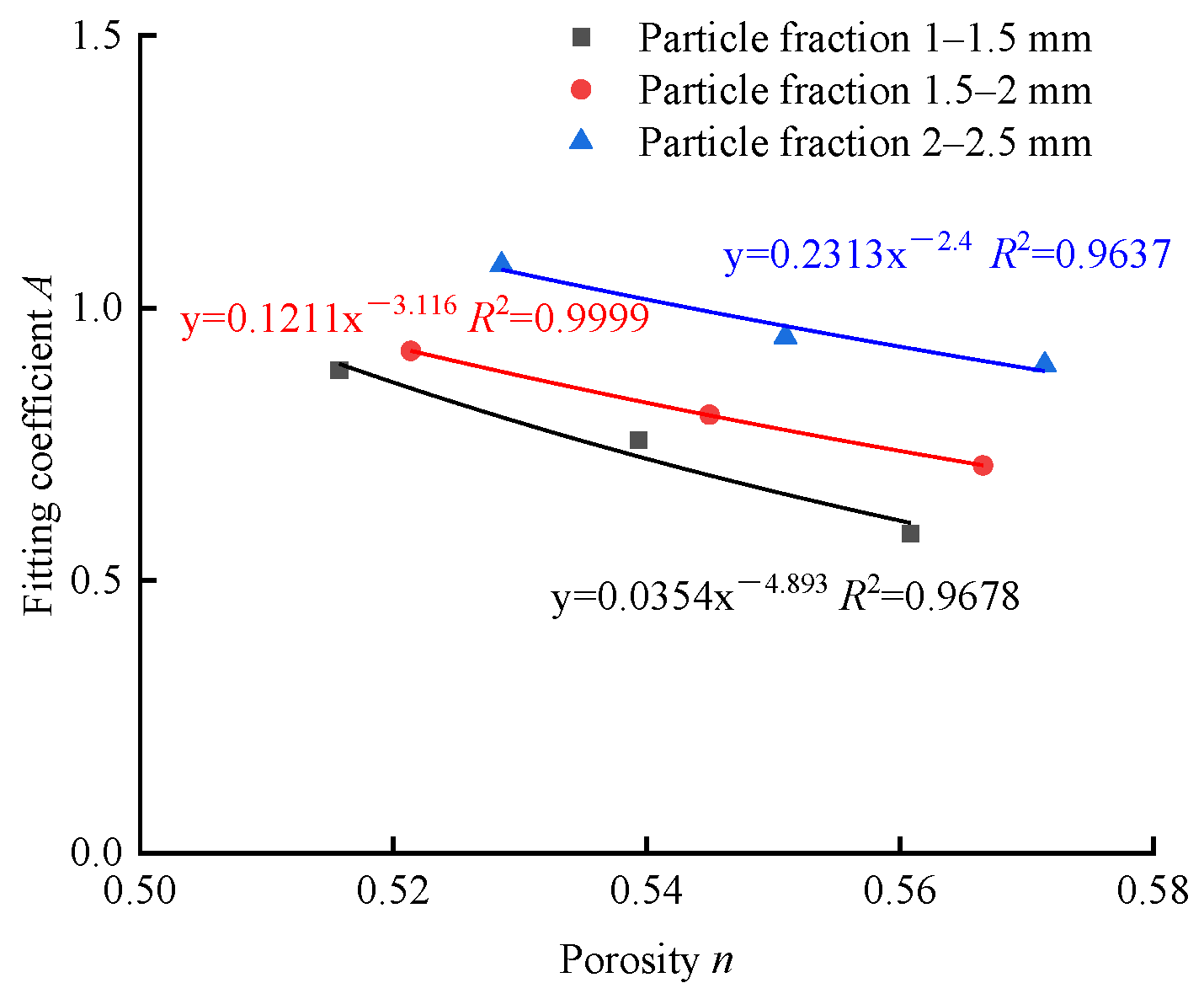
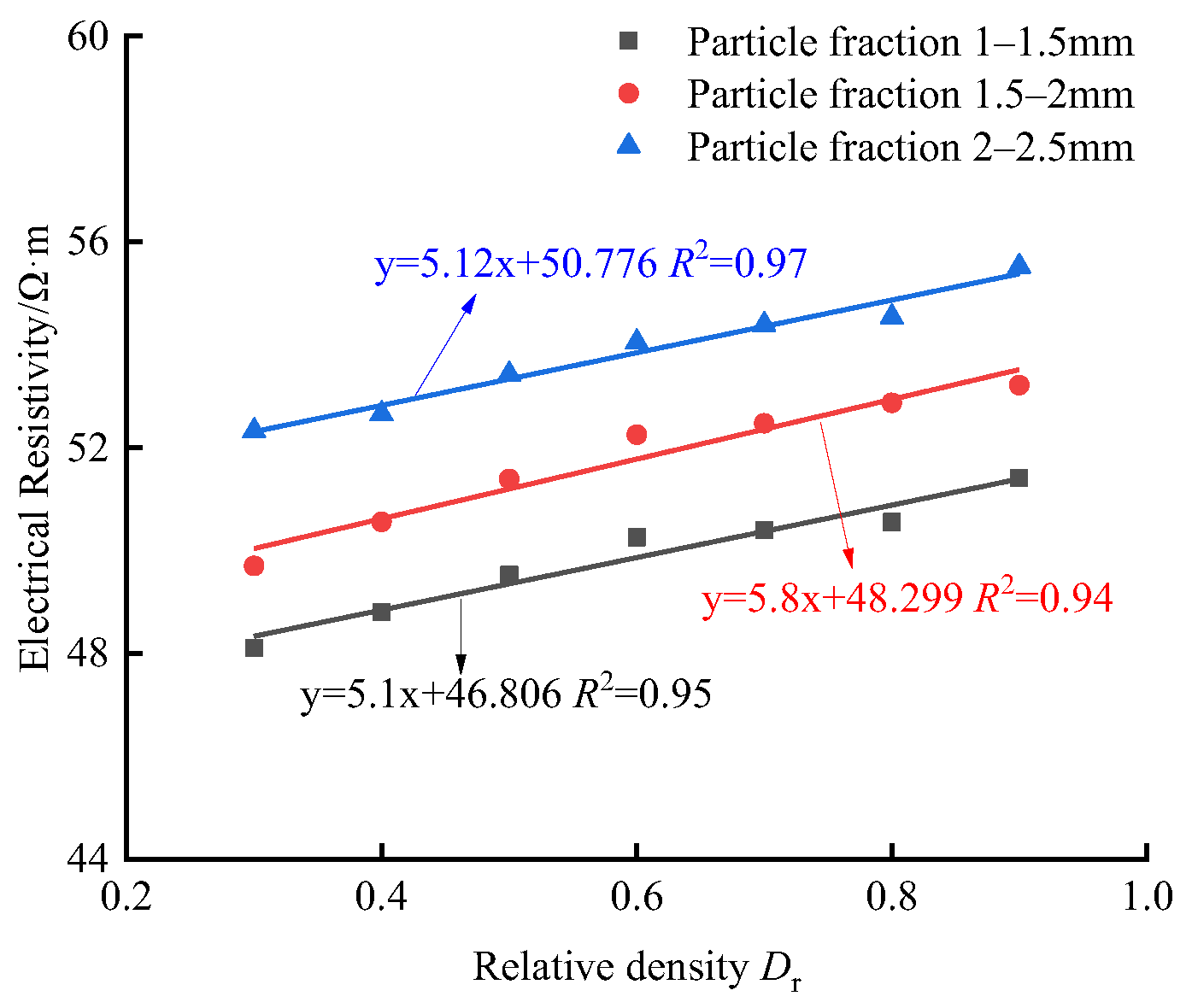
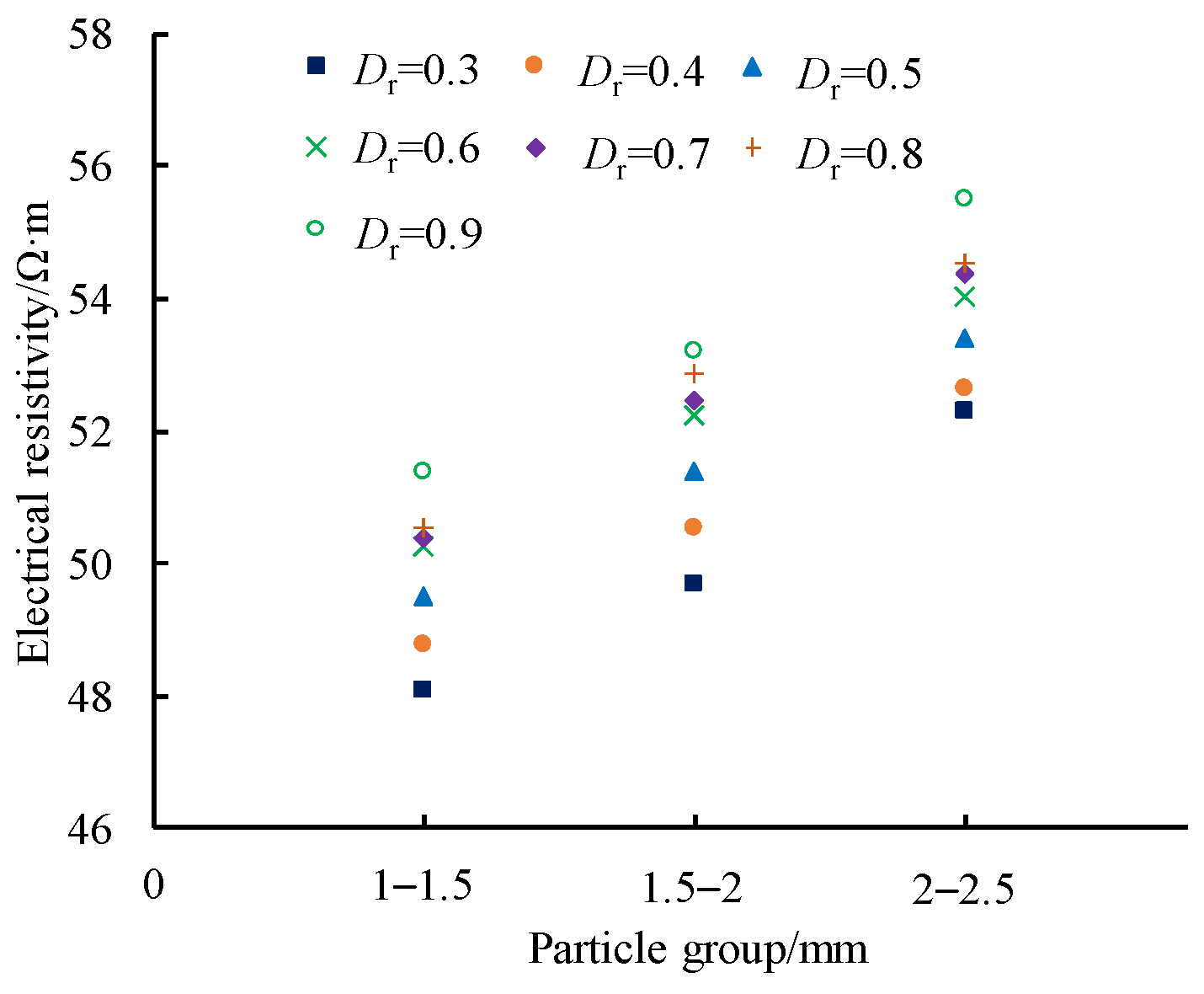
| Size Fraction /mm | Specific Gravity Gs | Maximum Dry Density /g·cm−3 | Minimum Dry Density /g·cm−3 |
|---|---|---|---|
| 1–1.5 | 2.74 | 1.35 | 1.15 |
| 1.5–2 | 2.73 | 1.33 | 1.13 |
| 2–2.5 | 2.71 | 1.30 | 1.11 |
| Influencing Factors | Size Fraction/mm | Saturation/% | Relative Density | Temperature/°C | Pore Water Type | Test Frequency/Hz |
|---|---|---|---|---|---|---|
| Pore water resistivity | 1–1.5 1.5–2 2–2.5 | 100 | 0.6 | 20 | Pure water, tap water, NaCl solutions with concentrations of 1%, 2%, 4%, and 6% | 1000 |
| Temperature | 1–1.5 1.5–2 2–2.5 | 100 | 0.6 | 5, 10, 15, 20, 25, 30, 35, 40 | Tap water | 1000 |
| Saturation | 1–1.5 1.5–2 2–2.5 | 20, 40, 60, 80, 100 | 0.6 | 20 | Tap water | 1000 |
| Relative density | 1–1.5 1.5–2 2–2.5 | 100 | 0.3, 0.4, 0.5, 0.6, 0.7, 0.8, 0.9 | 20 | Tap water | 1000 |
| Size Fraction/mm | Relationship between Resistivity and Temperature | R2 |
|---|---|---|
| 1–1.5 | ρ = −0.5076ln(T) + 33.40 | 0.955 |
| 1.5–2 | ρ = −0.9410ln(T) + 60.57 | 0.977 |
| 2–2.5 | ρ = −1.1453ln(T) + 73.67 | 0.972 |
| Size Fraction /mm | Relative Density Dr | A | n | B | m | R2 |
|---|---|---|---|---|---|---|
| 1–1.5 | 0.3 | 0.586 | 0.5609 | 0.0358 | 4.893 | 0.9678 |
| 0.6 | 0.758 | 0.5394 | ||||
| 0.9 | 0.886 | 0.5157 | ||||
| 1.5–2 | 0.3 | 0.711 | 0.5666 | 0.1211 | 3.116 | 0.9999 |
| 0.6 | 0.804 | 0.5450 | ||||
| 0.9 | 0.921 | 0.5214 | ||||
| 2–2.5 | 0.3 | 0.896 | 0.5714 | 0.2313 | 2.4 | 0.9637 |
| 0.6 | 0.947 | 0.5510 | ||||
| 0.9 | 1.079 | 0.5285 |
| Size Fraction/mm | Relationship between Saturation and Structure Factor |
|---|---|
| 1–1.5 | |
| 1.5–2 | |
| 2–2.5 |
| Size Fraction/mm | 1–1.5 | 1.5–2 | 2–2.5 |
|---|---|---|---|
| Slope | 5.1 | 5.8 | 5.12 |
| Intercept | 46.806 | 48.299 | 50.776 |
| Fitting coefficient | 0.95 | 0.94 | 0.97 |
Disclaimer/Publisher’s Note: The statements, opinions and data contained in all publications are solely those of the individual author(s) and contributor(s) and not of MDPI and/or the editor(s). MDPI and/or the editor(s) disclaim responsibility for any injury to people or property resulting from any ideas, methods, instructions or products referred to in the content. |
© 2023 by the authors. Licensee MDPI, Basel, Switzerland. This article is an open access article distributed under the terms and conditions of the Creative Commons Attribution (CC BY) license (https://creativecommons.org/licenses/by/4.0/).
Share and Cite
Hou, H.; Han, W.; Li, T.; Wang, H.; Du, X.; Liu, Z.; Wang, L. Experimental Study on the Electrical Resistivity Characteristics of Uniformly Graded Calcareous Sand. Appl. Sci. 2023, 13, 11467. https://doi.org/10.3390/app132011467
Hou H, Han W, Li T, Wang H, Du X, Liu Z, Wang L. Experimental Study on the Electrical Resistivity Characteristics of Uniformly Graded Calcareous Sand. Applied Sciences. 2023; 13(20):11467. https://doi.org/10.3390/app132011467
Chicago/Turabian StyleHou, Heying, Wei Han, Tianxiang Li, Haiyuan Wang, Xiaolong Du, Zhe Liu, and Linhao Wang. 2023. "Experimental Study on the Electrical Resistivity Characteristics of Uniformly Graded Calcareous Sand" Applied Sciences 13, no. 20: 11467. https://doi.org/10.3390/app132011467




